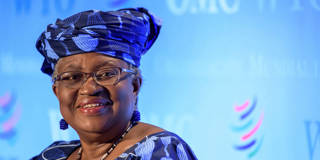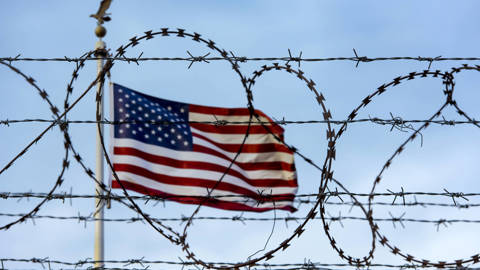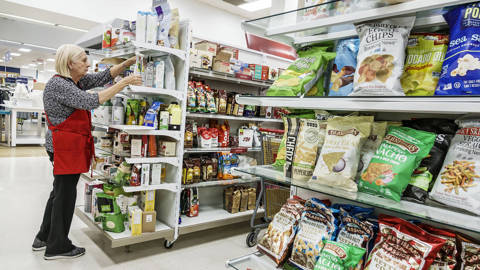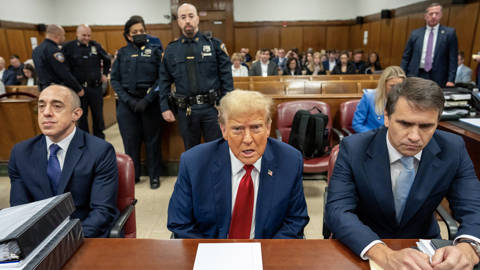The Trade Agenda Today
Neither the breakdown of multilateralism nor the rise of the digital economy has made international trade and its central governing body any less important. An open, transparent, rules-based trading system remains crucial for driving economic development and addressing global problems like climate change.
From rising populism and the COVID-19 pandemic to Russia’s invasion of Ukraine, this has already been an extraordinarily difficult decade for global trade and the principles, rules, and multilateral institutions that sustain it. To assess the current state of the international trading system and what lies in store for it, Anne O. Krueger, a former chief economist at the World Bank, queries World Trade Organization Director-General Ngozi Okonjo-Iweala on what she sees as the biggest challenges and opportunities.
Hard Times
Anne O. Krueger: Following Russia’s invasion of Ukraine, trade has been weaponized to punish the Kremlin. What do you think the long-term consequences of this approach will be?
Ngozi Okonjo-Iweala: The war affects all multilateral organizations, and the WTO is no exception. Since member states cannot ignore the conflict, they will need to make their views known as they see fit, within the WTO and elsewhere.
The multilateral trading system had its origins in the idea that trade and interdependence would foster peace and prosperity, and that stable global relations would in turn facilitate trade flows. The past 75 years have been remarkably prosperous and peaceful by historical standards.
The war in Ukraine, and the response to it, is a reminder not only that trade, and economic interdependence more generally, can be weaponized, but that the effects cut both ways. At the same time, the fallout from the war has also further underscored the need for trade. Mitigating the food-security implications of the crisis will require cooperation to keep foodstuffs and key inputs moving across borders. That is why we are working closely with the United Nations Food and Agriculture Organization and other international organizations to encourage solutions in this area.
Broadly speaking, we need deeper, more diversified, and more deconcentrated world markets. Such markets would be more resilient to shocks, and harder for any country to weaponize. But we cannot get there without a strong and effective multilateral framework of rules.
That was why it was so important that all 164 WTO members were able to reach a consensus at our recent 12th Ministerial Conference (MC12) in June. Their success showed that the multilateral system can still deliver results, despite the current challenges. It suggested that strategic cooperation can coexist with strategic competition.
AK: Long before you came to the WTO, you were well acquainted with international organizations, both as Nigeria’s finance minister and from your tenure at the World Bank. Did anything surprise you when you started your new job?
NOI: I was struck by the lack of focus on results, and the sheer amount of time it takes to negotiate important agreements. It has taken more than two decades to negotiate agreements on the sustainability of our fisheries and oceans, and on agriculture. Talks on the intellectual-property waiver to support the manufacture of COVID-19 vaccines dragged on even as people were dying.
What attracted me to the WTO was its central purpose, which is to make trade work for people. If you care about people, about sustainability, you cannot take so long to complete agreements and get results.
New Problems
AK: Many regard the WTO’s dispute-settlement mechanism as one of its major achievements, especially after the changes made in the Uruguay Round (1986-94). But the DSM has been left in limbo because of the US government’s refusal to approve the appointment of new judges to the Appellate Body. How do you think the DSM can be restored and perhaps even strengthened?
NOI: The system has worked well in helping members resolve trade disputes, including some very difficult ones, in a rules-based and objective manner over the years.

Subscribe to PS Digital
Access every new PS commentary, our entire On Point suite of subscriber-exclusive content – including Longer Reads, Insider Interviews, Big Picture/Big Question, and Say More – and the full PS archive.
But no system is perfect, and the DSM can be improved. The US has started the debate about strengthening the system at a technical level, and member states committed at MC12 to have a fully functioning system in place by 2024. This was an extremely positive outcome after years with no consensus among members in even articulating the challenges they face in this area.
Achieving the 2024 goal will require great commitment and determination from members. They are already talking to each other in various informal configurations about how they view their key interests in the dispute-settlement system, and how these interests can be best addressed in a reformed system. I think we will see these discussions evolve in the coming months.
AK: While the General Agreement on Tariffs and Trade (GATT) and the WTO played a valuable role in the international economy during the half-century after World War II, times have changed, leading some to wonder if the WTO has become less relevant in a rapidly digitalizing economy. How do you see the WTO’s role evolving? Should its agenda include issues like cybersecurity and e-commerce?
NOI: First, we shouldn’t underestimate the significance of merchandise trade, which was valued at $22 trillion in 2021 – 23% of global GDP. If goods didn’t matter, we wouldn’t have spent the past year worrying about supply-chain problems.
Moreover, the WTO is at the center of making merchandise trade more open and predictable. Globally, over 75% of goods are traded on Most-Favored-Nation terms (the tariff treatment that WTO members extend to each other on a non-discriminatory basis, with the European Union counting as a single market).
Even the digital economy runs on physical goods. The WTO’s Information Technology Agreement has eliminated tariffs on a wide range of products essential for the digital economy, such as servers, semiconductors, computers, and mobile phones. The ITA covers 83 members accounting for over 97% of world exports of such products. In 2015, it was expanded to eliminate tariffs on more than 200 products, for which trade in 2020 was valued at $1.8 trillion – equal to 19% of total global manufacturing exports.
That said, the WTO clearly needs to evolve – and it is doing so. We estimate that global exports of digitally delivered services have tripled since 2005, averaging remarkable 7.2% annual growth from 2005 to 2019. Since then, the pandemic-induced shift to e-commerce and remote work has accelerated this growth. In 2020, when trade in goods and in-person services shrank, digitally delivered services exports increased by 11%. Preliminary data suggest that world exports of computer services were up 34% in January-September 2021, compared with the same period in 2019.
Market commitments under the WTO’s telecommunications and financial services agreements have helped, as has the moratorium on imposing customs duties on electronic transmissions – which members agreed to extend at MC12.
To be sure, there are still no basic global trade rules for the digital economy. But WTO members are working to change this. The United States, the EU, China, and 83 other members are in the process of negotiating new rules on e-commerce, and cybersecurity is one of the key issues they are working on. Participants have already agreed on the outlines of potential future rules on issues like consumer protection, electronic signatures and contracts, paperless trading, and spam. Defining common parameters for digital trade will expand economic opportunities by lowering the bar for small businesses to participate in this fast-growing segment of the global economy.
Green Trade
AK: All multilateral institutions face growing demands to do more about climate change. How should the WTO approach this issue, given that many proposed reforms – not least carbon border-adjustment mechanisms – may run afoul of WTO rules or free-trade principles?
NOI: Trade is part of the solution to addressing climate change, and WTO members are increasingly responding to this imperative. In the formal outcome document from MC12, members “recognize[d] global environmental challenges including climate change,” together with the role of the multilateral trading system in meeting those challenges.
Many members are advancing new initiatives at the WTO that aim to leverage trade for environmental objectives. Some are revisiting the possibility of liberalizing trade in environmental goods and services – an issue that has been stalled since 2016 – to lower the cost of decarbonization. Others are seeking to address plastics pollution (by supporting the UN International Plastics Treaty negotiations), to promote more circular economies, and to reform fossil-fuel subsidies. There is also a new and very active discussion on trade-related climate measures; WTO members are discussing research and sharing their experiences.
But, as members seek to ensure that imports do not escape domestic carbon constraints, the proliferation of around 70 different national, subnational, and regional carbon-pricing approaches introduces the potential for trade frictions. I remain convinced that a shared global approach to carbon pricing is one of the best ways to send the right price signal for decarbonization, while minimizing possible trade tensions and ensuring that poor countries have a voice in the process. Of course, there are other tools, such as regulations and subsidies; but a global approach to carbon pricing should be seen as one of the essential tools for driving decarbonization.
To that end, the WTO is working with the World Bank, the International Monetary Fund, and the OECD to create a common factual basis for assessing carbon pricing. It has been heartening to see the trade community engage more with climate issues. For example, at MC12, trade ministers from the EU, Kenya, Ecuador, and New Zealand hosted some of their counterparts to discuss the possible creation of a “trade ministers for climate” coalition.
It is important to recognize that WTO rules provide ample regulatory space for implementing ambitious policies, provided that these policies do not constitute unjustifiable discrimination among trading partners. Greater coordination and cooperation in the design and implementation of national climate efforts can help defuse potential tensions while making environmental policies more effective. The WTO can be a venue to help facilitate such coordination and cooperation. Members have already notified WTO committees dealing with standards, market access, and agriculture of nearly 7,000 trade-related climate measures, only a tiny minority of which have led to disputes.
Trade and Development
AK: Many of today’s tensions in international trade arise from capital flows, especially foreign direct investment (FDI). Should the WTO play a role in addressing these concerns? What could it do to ease tensions?
NOI: True, the tensions around trade policy in recent years have less to do with the nature of trade rules per se than with global financial flows and macroeconomic imbalances. Recent history reminds us that crises arising from macroeconomic imbalances and financial vulnerabilities affect the real economy – including trade.
But even though large trade imbalances can fuel demands for damaging protectionism, trade policy can do little to correct underlying economic and exchange-rate imbalances rooted in savings and investment patterns. As WTO members recognized in a 1994 text on coherence in global economic policymaking, “difficulties the origins of which lie outside the trade field cannot be redressed through measures taken in the trade field alone.” Trade would benefit from the correction of macroeconomic imbalances, but those corrections need to happen elsewhere, because the WTO has no jurisdiction over capital flows.
We should be mindful that FDI can boost economic growth if it produces growth-enhancing structural change, employment creation, and technological diffusion. This is good for global demand and growth overall.
At the same time, FDI can be contentious because of its links with the offshoring of jobs and industrial activity. Yet there are potential benefits for home countries, too. For example, when US electronics firms were able to lower costs by locating manufacturing and assembly activities elsewhere, they could produce for a bigger market, which translated into more demand for higher-end design and marketing services within the US. But there are distributive implications here that can only really be addressed at the domestic level, though the OECD-led initiative on corporate taxation could help.
At the WTO, more than 110 members are participating in the Joint Initiative on Investment Facilitation for Development, which aims to forge a multilateral agreement that improves the business climate, making it easier for firms in all sectors of the economy to invest, conduct their day-to-day business, and expand their operations.
AK: China’s rise has been the single most important change in the political economy of trade, which makes Sino-American conflicts a growing concern for all participants in the trading system. Can the WTO help to ease these tensions?
NOI: China’s economic rise has been meteoric. In 2000, the year before it acceded to the WTO, China accounted for 3.9% of world merchandise exports. By 2020, this share had risen to 14.7%. Its share of imports over the same period rose from 3.4% to 11.5%. The country’s per capita income (in purchasing power parity terms) quintupled, from $2,890 to $17,110, while its share of global GDP (in PPP terms) more than doubled, from 7.3% to 18.3%.
For all the talk about tensions and decoupling, US-China merchandise trade has been at or near historic highs. US merchandise exports to China broke records last year, reaching $153 billion, while US imports from China were $542 billion – not far from the 2018 peak of $563 billion.
Actual decoupling would be costly for all economies. A strong multilateral trading system with global rules guaranteeing open trade between all major players is of paramount importance, especially for the lowest-income regions. Some of the US-China tensions arise from different economic models – specifically involving the degree of state intervention in the economy. In this regard, the WTO is doing a considerable amount of work to enhance the transparency of state interventions, including subsidies.
This April, a joint WTO, IMF, OECD, and World Bank report – Subsidies, Trade, and International Cooperation – noted that many subsidies are explicitly aimed at correcting market failures, while many others come with high domestic costs or harmful effects on the global commons. International cooperation that delivers improved subsidy disciplines can help ease some of the tensions between the US and China.
At MC12, we saw China and the US come together to bridge gaps and make outcomes possible in areas such as the proposed waiver to the Trade-Related Aspects of Intellectual Property Rights (TRIPS) Agreement. Similar cooperation at the WTO will be necessary for the multilateral trading system to manage tensions in the twenty-first century, including on e-commerce and environmental issues.
Revisiting the Rules
AK: The Uruguay Round made the first significant progress in addressing trade in agricultural commodities, but little has been done in the intervening years. Since it is almost always easier to liberalize trade – especially for agricultural goods – in good times, when prices are high, do you see a path forward for further liberalization of agricultural trade in the current context?
NOI: The Uruguay Round was definitely an important milestone in reforming trade in food and farm goods. It capped and cut tariffs and subsidy levels, while offering special arrangements for developing countries. But it did not go far enough, and many WTO members feel that much more needs to be done. Agriculture negotiations have unfortunately been dragging on.
Over the past quarter-century, the market and policy environment has changed significantly, making it increasingly clear that an update to WTO rules is overdue if we’re going to respond meaningfully to contemporary challenges.
The good news is that our successful Ministerial Conference in June showed that progress is possible, even on difficult issues. Through a declaration agreed at the conference, members committed to take concrete steps to facilitate trade, and to improve the functioning and long-term resilience of global markets for food and agriculture, as part of the response to today’s food-security challenges.
So, I’m hopeful that more progress can be achieved. While trade ministers couldn’t agree on a more detailed work program to guide the negotiations after the conference, I’m convinced that they all recognize the urgency and importance of taking action to reduce distortions and to liberalize trade further. Members’ domestic support entitlements now total $750 billion and will soon reach $1 trillion if nothing is done.
The war in Ukraine and this year’s floods, droughts, and other climate-driven disasters have brought new urgency to this issue. WTO members must act now to ensure that trade is a big part of the solution to the food-security challenges the world faces. We hope to explore how new approaches could deliver results in this crucial area.
AK: Some observers have suggested that the WTO is hamstrung by the unanimity requirement for rule changes. Does this need to be amended?
NOI: WTO members continue to regard consensus decision-making as a fundamental feature of the organization. Building a consensus is hard and takes time. Personally, I have asked myself whether there is a better, more efficient way, and what that would mean for all members. I am still reflecting on it. The value of the consensus system is that it ultimately delivers outcomes that everyone has signed up to. Every member, big or small, has a voice. The value of this should not be underestimated.
What would be helpful in preserving consensus decision-making at the WTO is to find open and flexible ways for members to advance discussions in areas where not all members are ready to participate. At the end of the day, keeping the door open by providing full transparency and opportunities for others to join at any time (in parallel with multilateral discussions) will help strengthen the consensus rule-making principle at the WTO.




